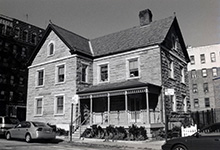
On Oct. 26, Lloyd Ultan—a veritable human encyclopedia of all things Boogie Down—marked his 15th year as the Bronx Borough Historian. Ultan, 73, is the longest-serving of the five borough historians, his term spanning those of three different borough presidents.
The Norwood News caught up with Ultan recently to get his take on how the Bronx has changed during his tenure, and to hear what he’s been up to lately.
Q:Where in the Bronx did you grow up, and where do you live now?
A: I was born on the Grand Concourse, near Morris Avenue, in a building that no longer exists that was then a maternity hospital. For the first 21 years of my life, I lived within walking distance of Yankee Stadium, and for the next 15 years I was actually on the Concourse. Now I live just south of Van Cortlandt Park.
Q: What’s your favorite place in the Bronx?
A: I never play favorites. There are lots of parts of the Bronx that have their own charm.
Q: When did you first get interested in the borough’s history?
A: I was always interested in history, even when I was toddler. I was always asking people about things that happened before I was born. After I finished my graduate work, I realized I knew about the history of New York and the history of the United States but I knew practically nothing about the history of the Bronx, where I grew up and lived. After a while, I realized the history of the Bronx was really the history of the country, in microcosm–every important event, every important movement, also happened in the Bronx, and the Bronx often had an influence on those.
Q: If you didn’t have this job, what would you be doing?
A: I’d always be studying history–my interest in history extends all over the globe. I also teach. I’m a professor at Fairleigh Dickinson University and I’m an adjunct professor Lehman College, where I teach the history of the Bronx.
Q: Tell us about your latest book.
I just handed my tenth book to the publisher.Tthis one is called “Blacks in the Colonial Bronx.” I’ve never seen anybody writing about the experience of blacks in the Bronx during that period. The idea was to bring it all together in one spot, and also to provide some historical context. It’s a fascinating story.
Q: Over the last 15 years, what’s the biggest change you’ve witnessed in the borough?
A: There’s been a gradual change in the image of the Bronx, from a negative one—the Bronx as place of devastation, high crime—to a much more positive one of people who work together to rebuild the borough, and restore it to its traditional place: an area where hardworking people can get ahead.
Q: How is the Bronx different from the rest of the city?
A: The Bronx urbanized rather rapidly. In the 1920s, because of the expansion of the subway, the Bronx became heavily populated with a multitude of ethnic groups that had to live together and all had the same aspirations, and they all got along. Even today, most people coming to the borough from outside remark that the people of the Bronx are very friendly.




